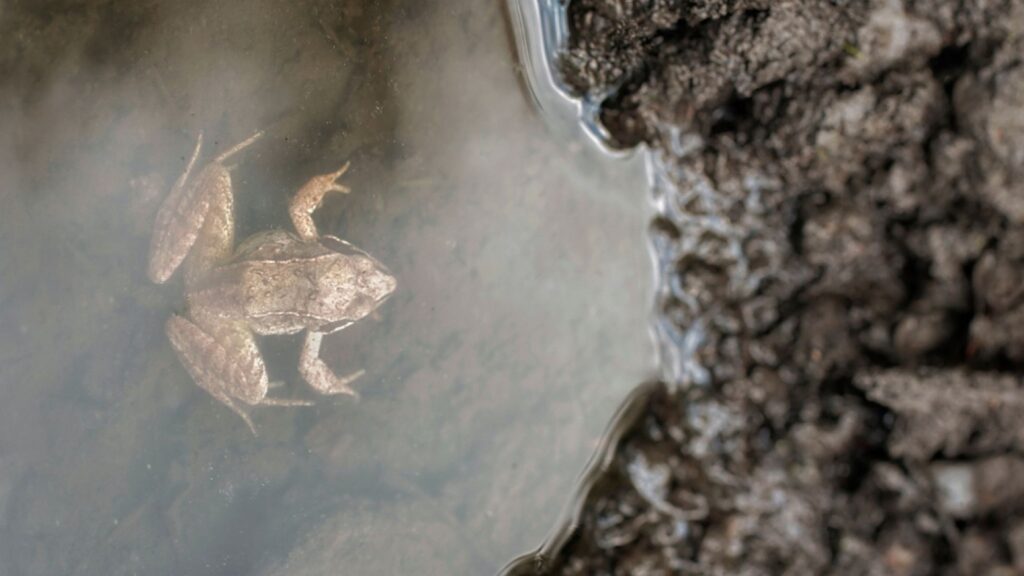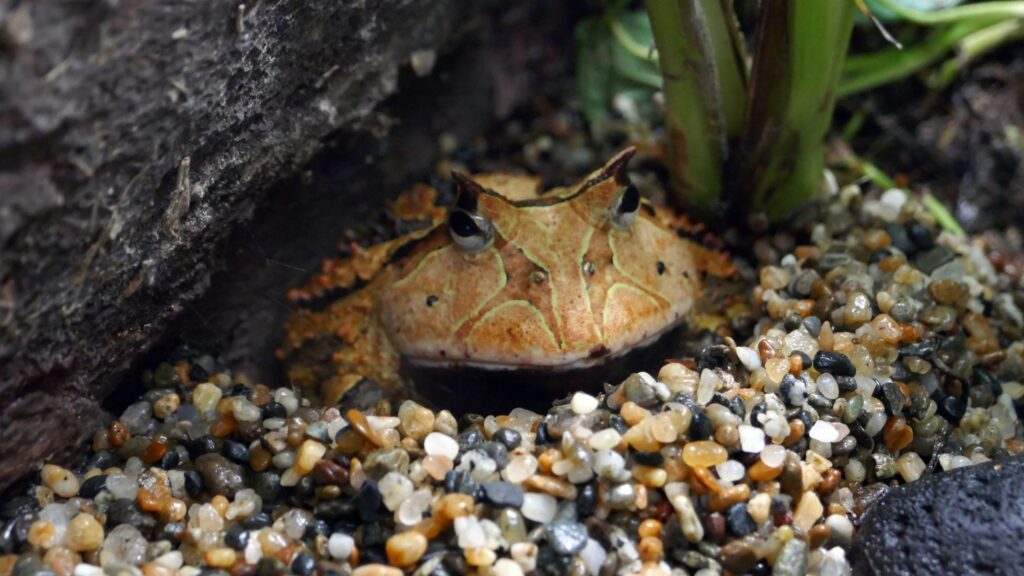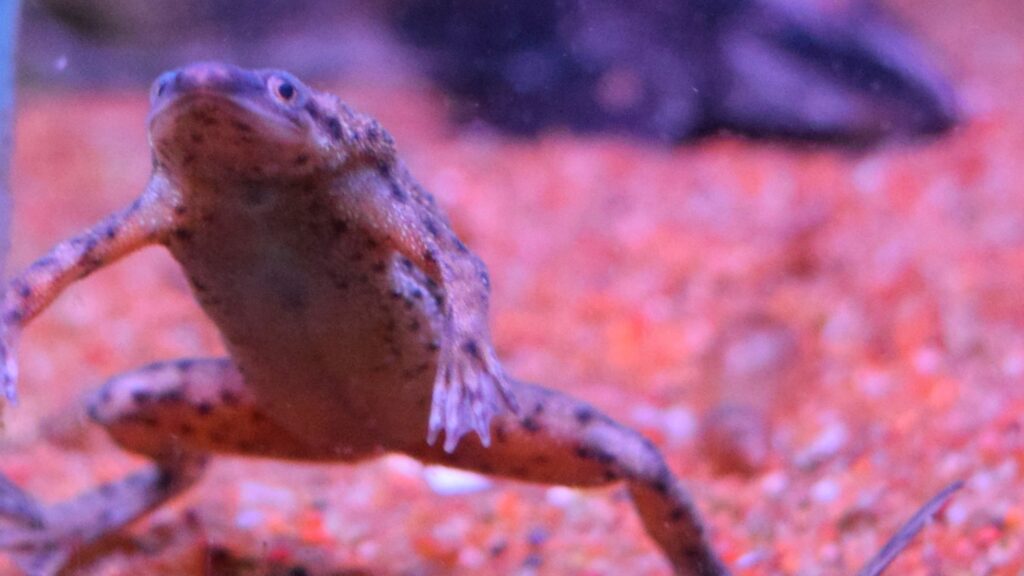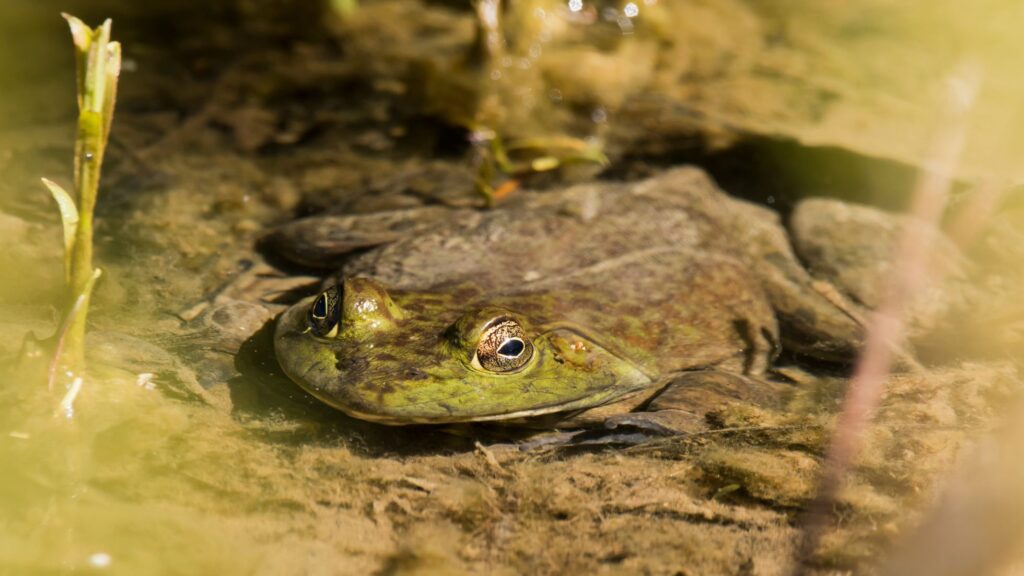One of the most interesting questions about frogs is whether or not they can breathe underwater. The answer is yes, frogs can breathe underwater, and they do this by cutaneous respiration, which means that they take in oxygen through their skin.
Frogs can breathe through their thin, moist skin, which works well for this type of respiration. They have adapted to various aquatic environments, including ponds, swamps, and streams.
Frogs spend most of their time in water, where they can breathe through their skin. How long a frog can stay underwater depends on its species and the conditions of its environment.
Some frogs can stay underwater for 4–7 hours, while others can only do it for a few minutes.
In this guide, we delve into the biology of frog respiration and explore the adaptations that enable them to breathe underwater.
You can also read: 10 weird facts about frogs you need to know.
Let’s get straight to the point!
How do Frogs Breathe Underwater?
We first need to understand their unusual respiratory system to get a good grip on how frogs can breathe while immersed in water.
Frogs take two different approaches to breathing, unlike humans, who only use their lungs.
Frogs do most of their breathing on land through their lungs, taking in air through their nostrils and exhaling carbon dioxide through their mouths. However, when a frog is wholly submerged in water, the conventional method of breathing through the lungs is no longer an option, so frogs breathe from their skin in a process called cutaneous respiration.
There are two ways for frogs to breathe underwater: through their lungs and their skin.
How much oxygen a frog can take in through its skin depends on how thick its skin is and how much blood is running through it.
Tree frogs and other frogs with thin, wet skin are better at absorbing oxygen through their skin than toads and other frogs with thick, dry skin.
What Is Cutaneous Respiration?
Cutaneous respiration, also known as cutaneous gas exchange, is a type of respiration in which an organism’s skin or outside epidermis, as opposed to its gills or lungs, is the site where gas exchange occurs.
Amazingly, frogs have developed a mechanism called cutaneous respiration that allows them to take in oxygen through their skin rather than their lungs.
The capillaries right under the skin’s surface facilitate this process. Submerged, their wet skin allows oxygen from the water to enter their bloodstream while allowing carbon dioxide to escape.
When frogs need to stay underwater for long periods, this adaption provides a lifeline that ensures they can continue to breathe.
How Long Can Frogs Stay Underwater?
How long a frog can stay underwater depends on the frog’s type, the water’s temperature, and how active the frog is.
The most time most frogs can spend underwater is between 4 and 7 hours. But some species can stay underwater for much more extended periods.
For example, the Surinam toad can stay underwater for up to 23 hours daily, and the wood frog can hibernate underwater for up to 4 months.

Wood frog under water
When a frog is underwater, its heartbeat and breathing slow down. This helps the frog to save oxygen. The frog’s skin also becomes more permeable to oxygen, which lets the frog take in more oxygen.
How long a frog can stay underwater also depends on how warm the water is. When the water is warmer, it is easier for frogs to take in oxygen than cold water. This is because there is more oxygen in the water that is warmer.
How long a frog can stay underwater also depends on how busy it is. When swimming or hunting, a frog needs more oxygen than just sitting still.
Do frogs have lungs?
Yes, frogs do have lungs. They use their lungs to breathe when they are on land. They also have thin, moist skin that lets them get oxygen from the water.
However, their lungs are not as well-developed as those of mammals or birds. Frogs can also breathe through their skin, so they don’t need to use their lungs as much.
The lungs of frogs are in their chest cavity. They are small and simple and aren’t made the same way as the lungs of mammals or birds.
The lungs of frogs are made up of a group of sacs connected to the windpipe. The air sacs are lined with a thin layer of tissue that lets oxygen move into the bloodstream.
Frogs breathe by getting air into their lungs through their nostrils. The air goes down the windpipe and into the lungs.
The oxygen in the air diffuses into the bloodstream, then the carbon dioxide in the blood passes into the lungs. The air then exits the lungs through the nostrils.
Can Frogs Drown?
Yes, frogs can drown. Although frogs can breathe through their skin, they must also come to the surface to breathe air. If a frog is submerged for excessive time, it will eventually die from drowning.
The length of time a frog may remain underwater before it drowns is determined by the temperature of the water in which it lives and the species of frog it is.
While some species of frogs can remain submerged for as long as several hours, others can only do so for a few minutes.
Several factors can make it more likely for a frog to drown. These factors are:
- Getting stuck underwater in a container or something else.
- When frogs are in cold water.
- When frogs are injured or sick
- Being in water that has toxins or pollution in it.
If you find a frog struggling to breathe, you can help it by putting it in a shallow container of water with some air holes.
You can also touch the frog’s back in a gentle way to help it breathe.
Can All Frogs Breathe Underwater?
No, not all frogs can live underwater and breathe. The young stage of a frog, called a tadpole, can breathe underwater through its gills. But as frogs grow up, they lose their gills and get lungs instead.
Adult frogs can still breathe a little bit through their skin when underwater, but they can’t stay underwater for long periods.
There are a few frog species that need to follow this rule. The wood frog and the Surinam toad can stay underwater for a long time.
The Surinam toad can stay underwater for up to 23 hours a day, and the wood frog can spend up to 4 months hibernating underwater. This is possible because these frogs have unique features that let them absorb more oxygen through their skin.

Aquatic Adaptations of Frog
Frogs can take oxygen from water due to several anatomical characteristics that contribute to this ability.
To begin, their skin is extremely thin and porous, which makes for highly efficient gas exchange.
In addition, the high vascularity of the skin guarantees that a significant amount of surface area is available for the absorption of oxygen. Some species of aquatic frogs even have particular adaptations, such as skin folds, that further boost the efficiency of their respiratory systems.
The webbed feet of frogs aid them in swimming and capturing their prey.
Frogs can keep afloat because of their webbed feet, which is a significant adaptation for frogs who spend much time in the water.
Some frogs, like tadpoles, can breathe underwater because they have gills. This is important for tadpoles because they can’t breathe air until metamorphose into frogs.
Frogs’ eyes are on top of their heads, which lets them see both above and below the water. This is important for frogs that hunt for food underwater since they need to be able to see their prey.
The sticky material on a frog’s toe pads allows it to cling to objects like rocks and leaves. Frogs need this to maintain their position in the mud they call home.
Supplementary respiratory methods used by frogs to breathe underwater.
The Buccal Pumping Technique
A method known as buccal pumping is used by some frogs in addition to cutaneous respiration to improve the efficiency of their breathing while they are underwater.
This is accomplished by making a rhythmic expansion and contraction motion with their throat region, which generates a flow of water over the skin surfaces in their mouth.
Buccal pumping activity serves to make the gas exchange more efficient.
Oxygen Absorption through Mouth Lining
Yes, oxygen can get into a frog’s body through the lining of its mouth; this is called “buccal respiration.” Most frogs that spend much time underwater, like tree frogs and poison dart frogs, breathe through their mouths.
The inside of a frog’s mouth is very thin and wet, which lets it get oxygen from the water.
The oxygen gets into the bloodstream through the inside of the mouth.
Buccal respiration is less efficient than pulmonary respiration, breathing through the lungs. Still, it can help frogs live for a long time underwater.
Metabolic Adaptations of Frogs
When there is a significant reduction in the amount of oxygen in their environment, frogs have the remarkable capacity to enter a state of metabolic depression known as torpor.
In this state, they can save a lot of energy by slowing down their metabolic rate, allowing them to withstand extended periods underwater without receiving adequate oxygen.
This adaptation is beneficial for frogs while they are hibernating or submerged in conditions that are low in oxygen.
Frogs can make the most of the available oxygen by lowering their oxygen use, slowing down their metabolisms, and thus increasing their survival chances.
They are able to endure situations that would otherwise be fatal for animals with metabolic pathways that are less adaptable thanks to this technique.
Can Frogs Live in a Fish Tank?
Yes, some frogs can live in a fish tank. Certain species of frogs can indeed call a fish tank home. However, selecting the appropriate species of frog for the aquarium you have available is essential.
Some species of frogs cannot survive in the conditions of an aquarium.
The finest species of frogs to keep in a fish tank are those that can live their entire lives in the water and do not require to come out of the water to breathe.
You may consider The African dwarf frogs, African clawed frogs, Amazon milk frogs, and White’s tree frogs for your aquarium.

Because of their size, these frogs do not require significant space. In addition to that, taking care of them is relatively easy.
Conclusion
Having answered the question, Can Frogs Breathe Underwater? You will agree with me that the amazing realm of frogs is one that never fails to astonish us.
The capacity of some species of frogs to breathe underwater through a mix of cutaneous respiration, buccal pumping, and metabolic changes is a beautiful example of how nature has adapted to its environment.
Even while not all frogs have the same capabilities for long-term life in water, some that have a natural affinity for the water have developed the ability to thrive on both land and in water.
The pursuit of understanding these adaptations not only increases our admiration for the amphibians in question but also sheds light on the complex mechanisms by which life has colonized various habitats.
If you find this article exciting, do feel free to subscribe to our newsletter.
You may also like to read: Beginners Guide to Keeping Tree Frogs as Pets

